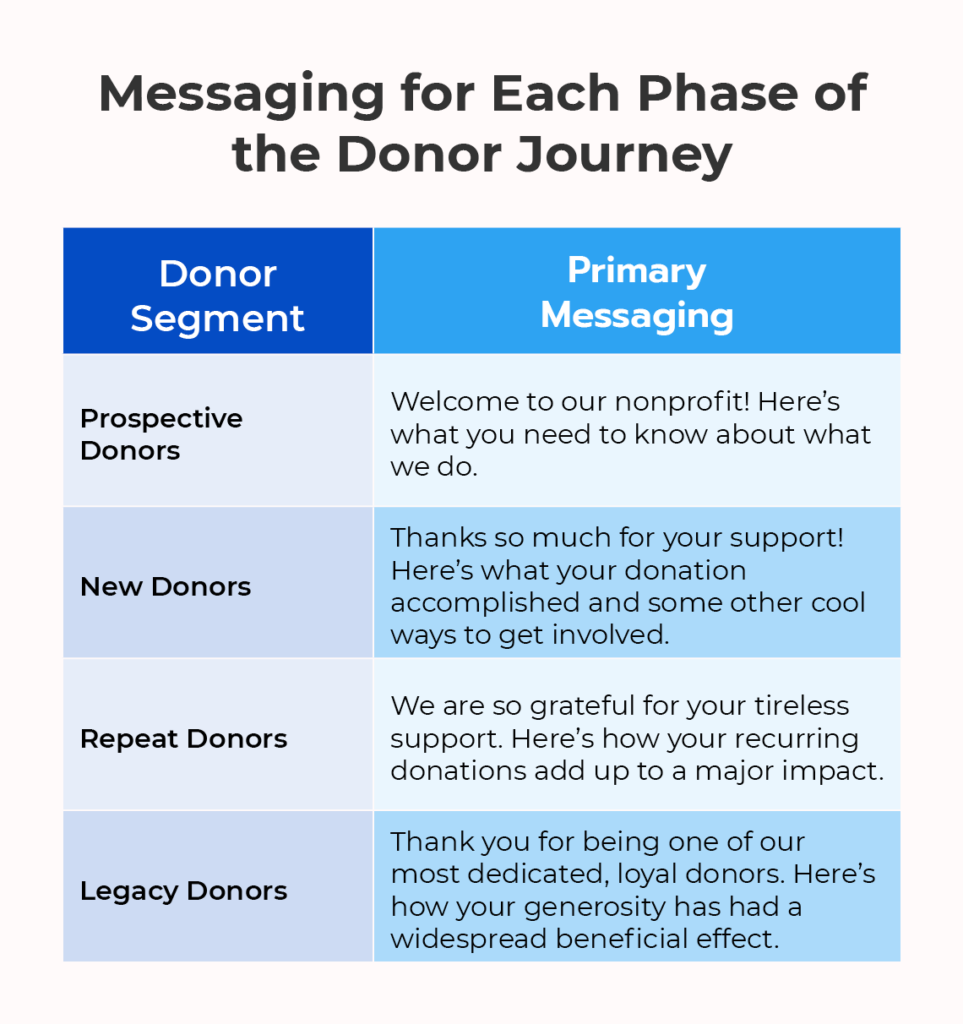Imagine one of your nonprofit’s longtime donors heads to the mailbox and sees a letter from your organization. They’re excited to learn more about your current projects and see how their donations are making a difference for your mission.
However, when they open the letter, they read, “5 Benefits of Joining Our Monthly Giving Program.” They’re immediately confused and somewhat displeased. They’ve been loyal annual donors to your nonprofit for years, contributing a yearly major gift of $5,000. They may think to themselves: “Is my contribution not valued by the organization I’ve supported for so many years?”
This example highlights the value of segmenting donors based on their position in the donor journey, known as lifecycle segmentation. This guide will review what lifecycle segmentation is, best practices for this style of data segmentation, and tips to overcome common challenges.
What is Lifecycle Segmentation?
Lifecycle segmentation is the process of grouping donors based on where they are in the donor journey. You can use these segments to craft more personalized outreach materials that speak to each group’s needs and interests. Ultimately, this strategy can help move donors further down the engagement funnel to become long-term supporters of your cause.
We’ll explore the following four donor segments based on their lifecycle phase:
- Prospective donors
- New donors
- Repeat donors
- Legacy donors
Using the information in your nonprofit’s constituent relationship management system (CRM), you can identify donors who fit into each category. Look at information such as donors’ giving anniversaries and frequencies to understand which lifecycle group they belong to.
Best Practices for Lifecycle Segmentation
Lifecycle segmentation can be an effective way to speak to your donors on a more personal level, but only when it’s carried out thoughtfully. Follow these best practices to segment donors effectively and develop tailored communications for each group.
Use clear segmentation criteria
The first step in segmenting donors based on their stage in the donor journey is to use clear parameters to define each segment. Accidentally grouping a donor into the wrong segment can have unintended negative consequences, like making donors feel disconnected from your organization.
Here are some ways you might define each of the primary lifecycle segments:
- Prospective donors: These individuals have engaged with your organization in some way but have yet to donate. Perhaps they’ve opened your emails, interacted with your social media posts, or filled out a form on your website. They may also have engaged with your mission in other ways, such as through volunteering or advocacy. You may have added prospects’ contact information from their previous interactions or form completions to your CRM or volunteer database.
- New donors: These supporters recently donated for the first time but have yet to make a second gift. After giving to your organization, you may have noted donors’ names, contact information, donation amount, and the date of their gift in your CRM.
- Repeat donors: These donors have supported your organization more than once within a given time frame, such as a month, quarter, or year.
- Legacy donors: These supporters have contributed to your nonprofit multiple years in a row. For example, you could define legacy donors as those who have given yearly for at least five years in a row and show no signs of stopping.
You might adjust these criteria slightly depending on your organization’s unique definitions for each category. Just make sure to employ these qualifications uniformly across your donor base to ensure you sort every supporter into the correct group.
Determine how to reach donors effectively at each stage
After developing your donor segments, strategize how you’ll communicate to each segment based on their unique needs and characteristics. Let’s break down useful outreach strategies by segment:

- Prospective donors are just getting to know your organization. Connect with them using social media posts, search ads, blog posts, and emails that spotlight your mission and programs. Ensure your online donation form is simple and convenient to encourage them to make the leap and become donors. Bloomerang’s donation page guide recommends only asking for necessary information like donors’ names, contact information, and payment details to help boost conversions and avoid data clutter.
- Primary message: “Welcome to our nonprofit! Here’s what you need to know about what we do.”
- New donors just gave to your nonprofit for the first time. Reach them with thank you messages, stories of how their donations made an impact, and invitations to engage in other aspects of your mission. For example, you can invite new donors to participate in volunteer activities or peer-to-peer fundraising events to deepen their involvement with your cause.
- Primary message: “Thanks so much for your support! Here’s what your donation accomplished and some other ways to get involved in our cause.”
- Repeat donors continue to show their support for your nonprofit through ongoing gifts. Keep these donors inspired and engaged by demonstrating the cumulative impact of their recurring donations. For instance, you could show monthly donors how their gifts help keep your community resource center stocked with necessary supplies.
- Primary message: “We are so grateful for your tireless support. Here’s how your recurring donations add up to a major impact.”
- Legacy donors are deeply engaged with your nonprofit and show their continued dedication through reliable giving. Show these donors the tremendous impact of their support by developing personalized impact statements that detail the positive change they’ve made for your mission over the years. For example, you could create a report showing how a major legacy donor has single-handedly helped send seven students to college with the help of scholarship funds.
- Primary message: “Thank you for being one of our most dedicated, loyal donors. Here’s how your generosity has had a widespread beneficial effect.”
As you can see, these outreach strategies and messages are designed to drive donors further down the lifecycle toward becoming legacy supporters. At the same time, they’re intended to meet donors where they are and provide them with appropriate resources for their current involvement stage.
Assess your progress and adjust your strategy as needed
Over time, your segmentation criteria could shift, or the characteristics of the donors within each segment could change. That’s why it’s important to reevaluate your segmentation approach regularly and adjust your strategy to account for evolving communication needs.
For example, let’s say you notice a demographic change within your legacy donor segment. Perhaps more of these donors are older, retired adults looking to find organizations to support with major donations and bequests. Studies have shown that older adults tend to prefer communicating in person or over the phone. With this in mind, you could adjust your outreach strategy to incorporate more in-person meetings or phone calls.
Tips to Overcome Segmentation Challenges
Like any marketing strategy, lifecycle segmentation involves a few potential challenges. Here are a few strategies to overcome common roadblocks.
Reduce data silos
Data silos are isolated segments of data. These silos can make it challenging to identify data trends or develop comprehensive segmentation criteria.
Poor cross-departmental communication, a lack of effective technology integrations, or inadequate data management practices may cause data silos. Mitigate them by taking the following steps:
- Ensure your fundraising tools integrate seamlessly for smooth data transfers between platforms. Integrations between your fundraising software, marketing tools, and CRM are especially crucial to maintaining clean donor data.
- Establish clear communication policies for sharing new data insights across teams. For example, you might leverage a reporting tool built into your CRM to make reports available to your full staff.
- Ensure your technology solutions have the necessary capacity to store your data. If you’re using an outdated CRM tool, for example, you might not be able to scale up your solution to handle larger volumes of data.
With clear workflows and data reporting across teams and platforms, you can ensure you have all the need-to-know information to approach segmentation with the right data at your fingertips.
Enrich your data as needed
The data enrichment process involves enhancing your internal database with third-party data from an external source. This practice helps make your donor profiles more comprehensive, allowing you to sort donors into their proper groups easily.
You can enrich your database with information such as donors’:
- Demographics
- Income
- Net worth
- Education
- Marital status
- Homeownership status
Essentially, you can append any type of information that isn’t immediately available after donors use your online fundraising software to submit a gift. Data enrichment can help you get to know your donors on a deeper level and choose the right communication channels according to each segment’s preferences.
Practice data hygiene
Poor data quality can cost a midsize business $1.2 million annually, causing organizations to miss out on potential customer connections and conversion opportunities. The same is true for nonprofits, making data hygiene a critical component of your segmentation process.
Practice data hygiene measures to ensure your data is accurate and up to date. These measures include:
- Regularly auditing your database to identify errors, duplicate data, or missing information
- Creating uniform data entry standards, such as guidelines for inputting phone numbers or street addresses
- Continually validating and updating your data with the help of data partners
Maintaining data cleanliness over the long term will be your best bet for keeping your segments updated.
Lifecycle segmentation is just one of many segmentation strategies that your nonprofit might use to group donors—and it’s a highly effective one. It’s a great way to improve the donor experience by providing a more personalized journey for each donor. Keep your data organized, updated, and free from silos, and you’ll be on your way to facilitating a smoother donor journey for all supporters.












0 Comments